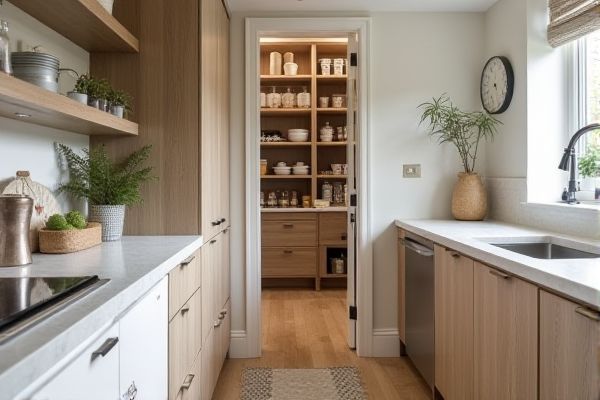
A deep pantry offers greater storage capacity and allows you to store larger or bulkier items, while a shallow pantry provides easier accessibility and visibility of contents, reducing clutter and making it faster to find your ingredients. Explore the rest of the article to discover which pantry style best suits your kitchen needs and lifestyle.
Table of Comparison
| Feature | Deep Pantry | Shallow Pantry |
|---|---|---|
| Storage Capacity | High volume, ideal for bulk items | Limited volume, suitable for daily essentials |
| Accessibility | Items may be harder to reach at the back | Easy access to all stored items |
| Organization | Requires careful organization to avoid clutter | Allows straightforward, visible arrangement |
| Space Utilization | Maximizes vertical and deep shelf space | Optimizes shallow depth, good for small spaces |
| Ideal User | Large households or bulk buyers | Small families or frequent shoppers |
Deep Pantry vs Shallow Pantry: Key Differences
Deep pantries offer increased storage capacity with shelves typically 24 inches or more in depth, allowing bulkier items and multiple rows of goods to be stored efficiently. Shallow pantries, usually 12 to 18 inches deep, provide easier access and better visibility of items but limit the volume of stored products. Choosing between deep and shallow pantries depends on kitchen size, storage needs, and accessibility preferences.
Space Efficiency: Maximizing Storage Capacity
Deep pantries maximize storage capacity by utilizing vertical space and allowing for larger containers, reducing clutter and optimizing overall organization. Shallow pantries improve accessibility by minimizing the need to move items around, but often sacrifice storage volume due to limited depth. Balancing depth and shelving design is essential for achieving optimal space efficiency in kitchen storage solutions.
Accessibility and Organization
Deep pantries provide ample storage space but can compromise accessibility, as items stored at the back may be hard to reach and get overlooked. Shallow pantries enhance organization by allowing you to clearly see and easily access all items, reducing clutter and making it simpler to maintain inventory. Your choice depends on whether maximizing storage or ensuring quick accessibility is a higher priority for your kitchen needs.
Cost Implications: Installation and Maintenance
Deep pantries typically incur higher installation costs due to the need for reinforced shelving and increased cabinetry materials, while shallow pantries are more budget-friendly with simpler construction requirements. Maintenance expenses for deep pantries can be greater because they require more frequent organization and potential repairs to support heavier storage loads. Shallow pantries often offer easier upkeep with less structural stress and simpler cleaning processes.
Best Foods and Items for Deep vs Shallow Pantries
Deep pantries excel at storing large, bulky items such as oversized cereal boxes, large jars of sauces, and bulk containers of grains, enabling easy stacking and maximizing vertical space. Shallow pantries are ideal for smaller, frequently used items like spice jars, canned goods, snack packs, and baking ingredients that benefit from quick access and visibility. Organizing foods by size and frequency of use ensures optimal space efficiency and reduces clutter in both deep and shallow pantry setups.
Suitability for Different Kitchen Sizes
Deep pantries maximize vertical storage, ideal for larger kitchens with ample wall space to accommodate extensive shelving and bulkier items. Shallow pantries suit smaller kitchens by providing easy access without overwhelming limited space, fitting neatly into narrower or compact areas. Your kitchen layout and available space will determine whether a deep or shallow pantry optimizes functionality and convenience.
Impact on Food Freshness and Waste
Deep pantries can lead to food being forgotten at the back, increasing the risk of spoilage and waste due to poor visibility and accessibility. Shallow pantries improve organization and make it easier to monitor expiration dates, helping maintain food freshness and reducing waste. Optimizing your pantry depth ensures better inventory management and extends the usability of your groceries.
Design and Customization Options
Deep pantries offer extensive storage space with adjustable shelving, pull-out drawers, and customizable compartments tailored to maximize vertical capacity and accommodate bulkier items. Shallow pantries favor compact designs with fixed shelves and door-mounted storage solutions, ideal for smaller kitchens but with limited flexibility. Both designs can integrate elements like lighting and labeling, but deep pantries provide more comprehensive customization options to suit varied organizational needs.
Cleaning and Upkeep Considerations
Deep pantries require more effort for cleaning and upkeep due to their larger storage space and harder-to-reach corners that can accumulate dust and spills. Shallow pantries offer easier access and more straightforward cleaning, reducing the time and effort needed to maintain organization and hygiene. Your choice between deep and shallow pantries should consider how much time you're willing to dedicate to regular cleaning and maintenance.
Choosing the Right Pantry for Your Lifestyle
Deep pantries offer extensive storage ideal for bulk buying and large families, maximizing vertical space with adjustable shelves for varied item sizes. Shallow pantries suit smaller kitchens and minimalist lifestyles, providing quick access to essentials without overwhelming the space. Evaluating cooking frequency, inventory size, and kitchen layout helps determine whether a deep or shallow pantry best supports your daily routines and space efficiency.
 homyna.com
homyna.com